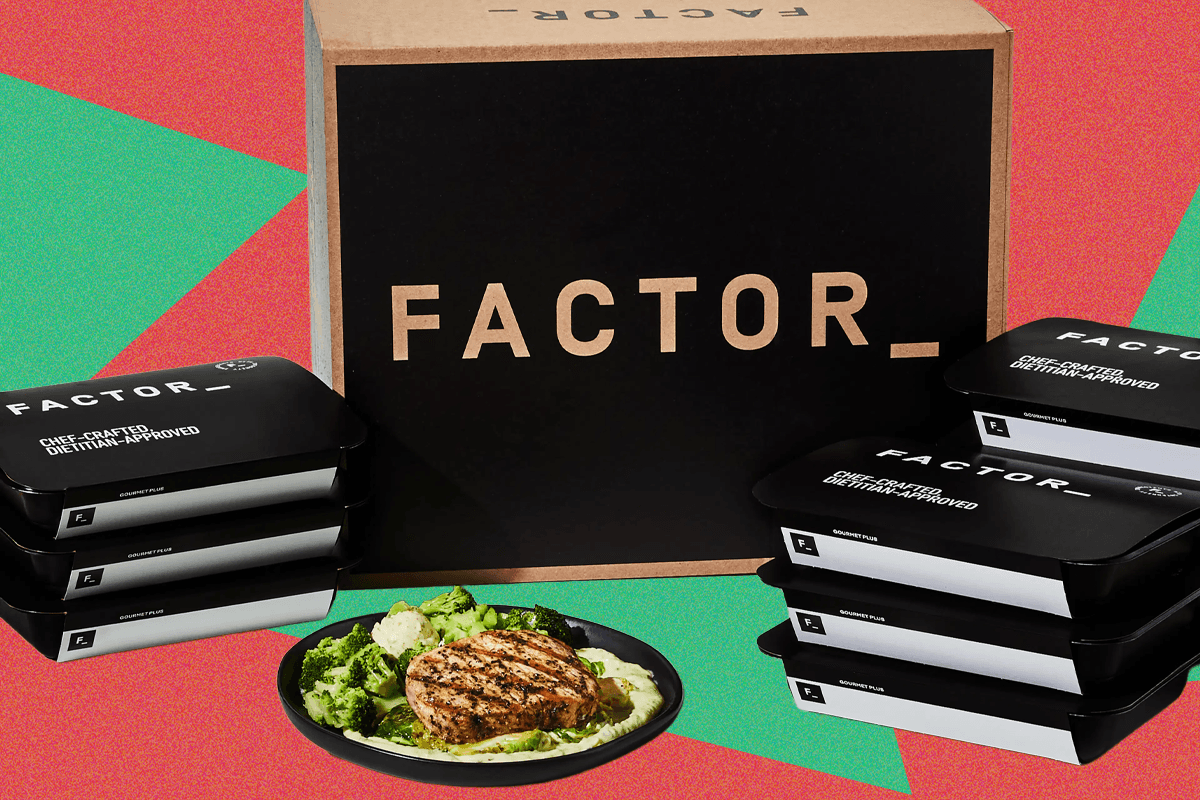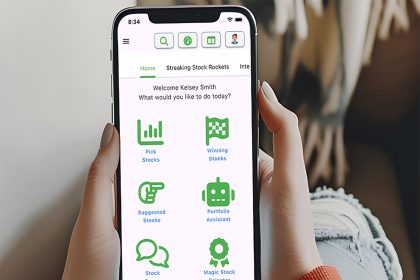I have gone utterly rogue with this pork loin.
Factor, HelloFresh’s prepared meal delivery service, does not offer instructions for heating up its meals with an air fryer. But I’ve gone a little off-script while testing Factor’s high-protein meal options, after my previous experience reheating Factor’s never-frozen, packaged delivery meals using the microwave. The air fryer works better. Wings? Garlic chicken? Truffle filet mignon? Everything goes into the Ninja Crispi, which has become by far my favorite device for livening up and reheating leftovers.
The key is, meat and veg go on the top. Rice, or wet food in general, goes on the bottom. After 10 minutes on the 380-degree-Fahrenheit recrisp setting, my brussels sprouts and pork loin bear none of the soggy hallmarks of reheated microwave food. They even take on light Maillard char atop the cooking plate. The nuttiness of buttery wild rice—cooked underneath the cooking plate—might even be better than the pork, sopped a little in juices from the pork resting above it.
Photograph: Matthew Korfhage
Honestly, it’s a good meal, almost homestyle—among the best I’ve tried from Factor, whose ready-to-eat meals have steadily improved in both taste and texture since WIRED began testing them a couple years back. Factor’s strong point has always been proteins, and so I decided to get with the times, trying out the high-protein diet that everyone on TikTok seems to think they need. On Factor, these are branded Protein Plus, each with more than 30 grams of protein.
Four days and 10 Protein Plus meals later, I realize I could probably live like this. I’m less hungry, on fewer calories. And I’m still eating my veggies. Though convenience does cost. Plans vary in price depending on the number of meals ordered, but each meal runs from $12 to $14 after introductory discounts expire, plus $11 shipping per week. In practice, this is less than take-out but significantly more than groceries or most freezer-case meals.
Pro-Protein
Photograph: Matthew Korfhage
As with all health fads, I am wildly dubious of self-appointed nutritionists on TikTok pushing 200 grams of whey protein per day as a life hack, not to mention crusaders who swear they eat only steak. The nutritive benefits of the all-ribeye diet are, needless to say, questionable. And as my colleague Boutayna Chokrane noted earlier this year, you’re … probably getting enough protein already.
But for many, a little extra protein has become a way to maintain energy and muscle mass while eating less overall—whether because protein makes you feel more full, or because you happen to be taking GLP-1 medications and you’re less hungry anyway. Fully 61 percent of adults last year said they were trying to increase protein intake, according to Cargill’s 2025 Protein Profile, and protein powders in your morning drink have become about as common as matcha.
Technically, I’m caffeine-jazzed on an almond milk protein latte from Factor as I type these lines—the things I do for science!—and it’s not bad. It’s like a slightly dusty Frappuccino. But what’s attractive to me about Factor’s Protein Plus options overall is that they’re the opposite of protein shakes and smoothies. They’re food.
It’s not a meal plan, per se—but if you select “high protein” as your preferred diet, the 50 or so Protein Plus options will be shown to you first on the menu. Each contains 30 grams or more of protein on a meal that might be about 500 to 600 calories.
What I found is that this keeps me feeling significantly more full than if I’d invested the same number of calories as carbs: Three meals like this is maybe 1,500 to 1,800 calories, a little less than I’d normally eat as a man my size. But I didn’t feel hungry during the day. It’s an odd version of diet plan, if it’s a diet—stocking my body up on meat so I’m less likely to feel hunger pangs for empty carbs.
Macro Comfort
Photograph: Matthew Korfhage
The meals are mostly satisfying, though rarely do they stray into exciting territory. Factor, like most ready-to-eat meals, is not often the stuff of Instagram stories. But unlike a lot of the more extreme protein-happy TikTok or MAHA diet plans, the high-protein meals from Factor generally also involve veggies.
The Protein Plus options are pretty broad, comprising about half of Factor’s menu items overall. The meals remain mostly stolidly middle American: garlic herb chicken, barbecue wings, a red pepper frittata for breakfast. Jamaican jerk salmon and a Thai yellow curry chicken were among the most peripatetic options I tried, but even these feel domesticated, accessibly tame. (I did in fact like the jerk salmon a lot more than I expected to.)
Most dishes, though, are classic square meals: a meat, a starch, a veggie that’s probably green. It’s almost wholesome, Midwestern mom food. Heck, Factor—founded and based in Illinois—even has a Midwesterner’s sense of improvised adventure: An “unstuffed pepper” is basically the rice and meat and tomato sauce you’d canonically stuff into a bell pepper, but delivered in saucy meatball form with bell pepper bits strewn amid the rice. It looked sloppy, and it tasted like pure distilled comfort. If you hate what’s essentially a peppery meatball stew, I don’t know you.
Photograph: Matthew Korfhage
In bygone years, Factor was perhaps over-reliant on mashes and hashes to fill out meals, but these made only a few appearances—including an actually kinda tasty mashed potatoes with leeks, served as a gloppy side to a pleasantly thick slab of filet mignon that arrived medium-rare, and reheated up to more like medium.
The proteins, uniformly, came out tender and relatively juicy, whether chicken or shrimp or beef. Reheated veggies are always difficult to manage in terms of texture, and that was true here, too. In general, Factor’s veggies were likely to be a little soggy if you nuked them—and a lot better if you put them in an air fryer or convection oven. Also, steer toward meals with brown and wild rice over white or “risotto.”
Over the Long Haul
Photograph: Matthew Korfhage
I will always like fresh-cooked food better than meals that have been prepared and reheated from a box: The brightness of a fresh tomato, the pop of a pea, the lively crispness of a just-so carrot, are impossible to replicate in food made yesterday or last week. But proteins and stews fared pretty well in particular, and so the Protein Plus options amounted to my best experience with Factor. It was also among my favorite prepared meal services overall. (See also WIRED’s guide to the best delivery meal kits.)
Prepared meals involve quite a bit of science: Certain ingredients don’t pair well with others when shipped together in a box. Chemicals in capers can cause meat to spoil. Almost all ready-to-eat meal delivery companies make use of a technology called modified atmosphere packaging, which modifies the composition of the air to allow food to stay fresh longer when packed in airtight packaging. That’s why it’s still good a week later, without being frozen.
Factor wouldn’t go on record about their proprietary packaging tech, but they have clearly devoted a lot of time to managing moisture, and avoiding the sogginess that plagued their meals even a year or two back. Which all adds up to the fact that I still enjoyed my four days of eating basically nothing but Factor’s prepared meals. And that I’m a great deal happier knowing there’s a Factor meal in the fridge, as opposed to a Stouffer’s in the freezer. (Though I also love Stouffer’s frozen lasagna and will die on that hill.)
Photograph: Matthew Korfhage
But over the long term, I’d still probably not use Factor as a full meal replacement for very long, even if I were trying to manage a high-protein diet. Factor’s meals attend pretty closely to macros, and its high-protein meals are indeed filling without high calories. But they’re also often high in sodium and saturated fat, meaning caution is necessary before eating them for multiple meals a day over long periods.
But as to whether I’d like some of those “unstuffed pepper” meatballs right now? The ones I already ate? Yeah, probably.












